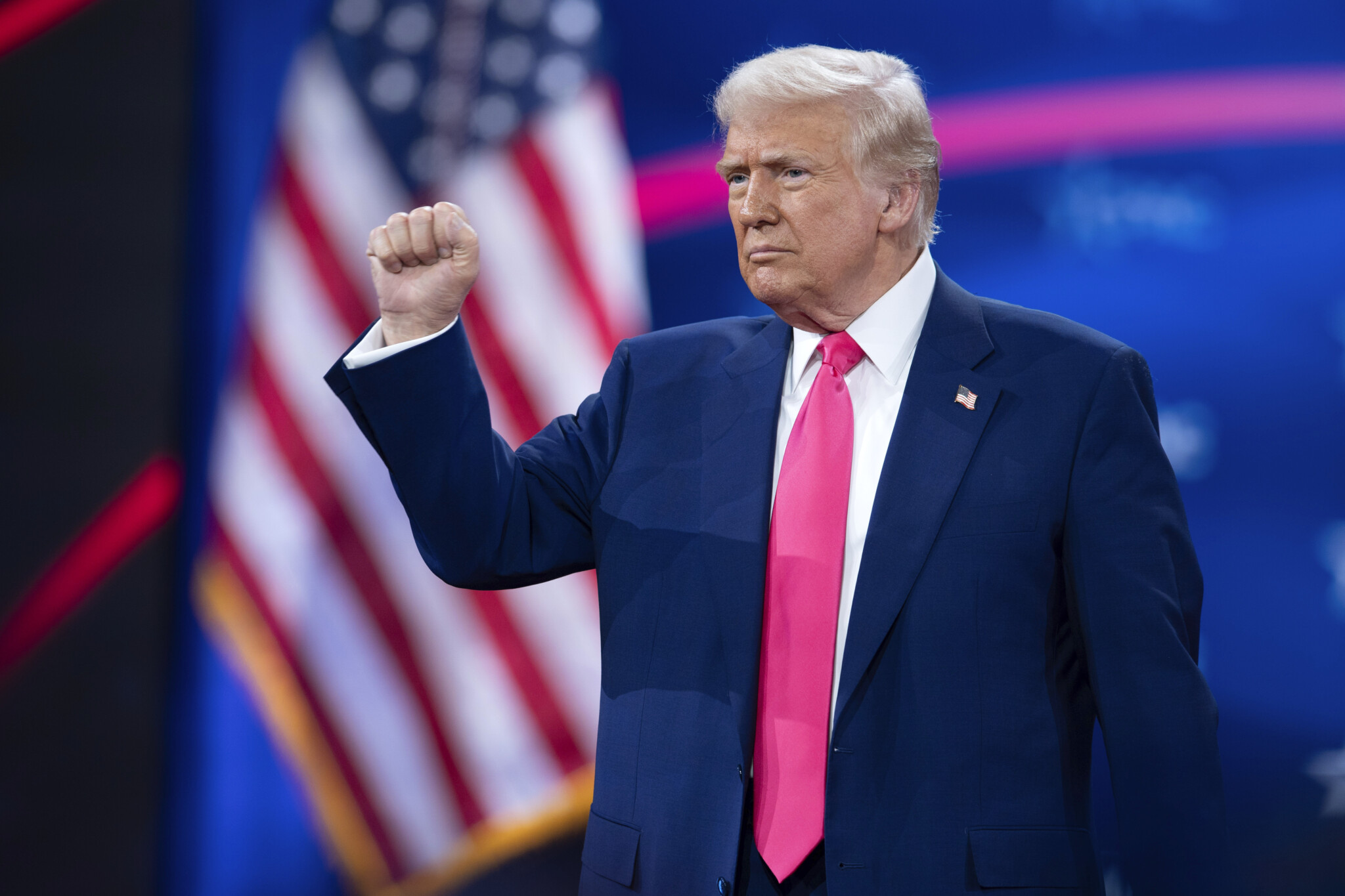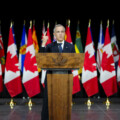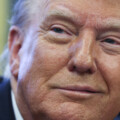Welcome to The Think Tank, your Saturday dive into thought-provoking research from think tanks, academics, and leading policy thinkers in Canada and around the world, curated by The Hub. Here’s what’s got us thinking this week.
“Liberation Day” has come, and it looks as if President Trump just launched an economic war against the world. On Wednesday, the U.S. president imposed at least a 10 percent tariff on nearly all countries. But if a country received a 10 percent tariff, they should consider themselves lucky.
The European Union was hit with 20 percent tariffs. For Vietnam, where a lot of Chinese manufacturing has actually shifted to avoid U.S. tariffs, the levy was set to 46 percent. China has been hit with a 34 percent tariff, which appears to be on top of existing tariff rates, meaning that Chinese goods entering the U.S. will be north of 50 percent.
While Canada looks to have largely been spared from the worst of the “reciprocal” tariff pain, what is becoming clear to analysts is that Trump’s trade war will be an economic and geopolitical conundrum, and U.S. consumers will suffer. Meanwhile, the idea that domestic industries will flourish doesn’t fit with the historical experience of trade wars.
This week, Trump’s actions appear to have driven China, Japan, and South Korea, countries that have all been adversaries with each other in the last century, closer together as it was reported that they would coordinate their responses to American tariffs.
How the trade war unfolds remains to be seen. Countries will retaliate, spreading the economic damage around the world. But given Trump’s proclivity for backtracking, the world is watching to see how long this really lasts.
That said, let’s examine some research that can help us understand where the trade war is going.
Canada now knows why the U.S. is angry about trade
Before “Liberation Day” this week, we received a comprehensive overview of what the U.S. sees as foreign trade barriers, from the U.S. Trade Representative (USTR). At nearly 400 pages, the document is impressive in its scope. While it doesn’t look like the report was the ultimate basis of Trump’s reciprocal tariffs, it nevertheless gives us a sense of what U.S. grievances will be in future negotiations with Canada, like a forthcoming review of the Canada-United States-Mexico Agreement (CUSMA).
In the agricultural sector, supply management and Canada’s use of tariff-rate quotas (TRQs) for dairy were flagged as a major irritant. The U.S. asserted that the “supply-management system severely limits the ability of U.S. producers to increase exports to Canada above TRQ levels and increases the prices that Canadians pay for dairy and poultry products.” While there are questions about whether the U.S. import volumes have hit the levels where the TRQs kick in, our supply management system continues to hamper trade relations and cost Canadian consumers.
The report also addresses barriers in the alcoholic beverages market, particularly concerning the sale of U.S. wine in Canadian provinces with provincial liquor control boards. It notes that certain provincial policies favour local wines over imported ones, creating an uneven playing field for U.S. exporters.
In the realm of digital trade, the USTR raises concerns about Canada’s proposed digital services tax (DST), which would require foreign and domestic large businesses to pay a 3 percent tax on revenue earned from engaging with online users in Canada. The U.S. views the DST as potentially discriminatory against U.S. companies and inconsistent with international tax principles.
The broadcasting sector is another area of contention. The report points out that the Online Streaming Act extends Canadian Radio-television and Telecommunications Commission (CRTC) mandates to ensure preferential treatment for Canadian content, which may disadvantage U.S. programming and streaming services. The USTR also highlights that the legislation includes a new 5 percent levy on the Canadian revenues of streaming services starting in 2024–25 to support Canadian broadcasting. However, the U.S. notes that the criteria may exempt Canadian services while excluding American platforms from accessing the funds they help finance, raising concerns over USMCA compliance.
Furthermore, the USTR expresses concerns over Canada’s intellectual property rights enforcement, particularly regarding counterfeit goods and the perceived inadequacies in addressing online piracy.
The report also discusses several other trade concerns related to agricultural restrictions, Quebec’s language policies, and environmental protections.
While Canadian politicians have already defended some of these policies, like supply management, expect them to be the focal point of future negotiations.
History tells us that Trump’s tariffs will likely fail and leave long-term economic pain
The consensus of economists is that Trump’s tariffs will negatively impact the U.S. economy. With the addition of the “reciprocal” tariffs to the president’s other tariff policies, U.S. average tariff rates are now higher than they were during the Great Depression when the U.S. implemented the Smoot-Hawley tariffs. Economists also agree that those tariffs took a bad economic situation and made it worse.
But we don’t have to go so far back in time to understand the negative consequences of tariffs on steel. Forthcoming research in the American Economic Journal: Economic Policy has analyzed the local labour market effects of President Bush’s 2002 steel tariffs.
The researchers assessed employment effects at the regional level. They found no meaningful job growth in areas tied to American steel production, contradicting one of the key rationales for the policy. More notably, the study uncovered significant and enduring job losses in regions where steel is a crucial input—such as automotive, machinery, and construction materials manufacturing.
Even after the tariffs were lifted in late 2003, the negative employment impacts persisted, with a lasting reduction in the number of steel-intensive manufacturing firms. This suggests that short-term protectionist policies can inflict long-term structural damage. The authors argue that firms affected by higher input costs may close or relocate, leading to permanent losses in employment and capacity that outlast the policy itself.
The study adds to a growing body of evidence warning against the blunt use of trade barriers as a tool for economic protection.
How should we make sense of Trump’s worldview? Here’s one professor’s theory
So, what are Hub readers to make of “Liberation Day”? What explains the Trump Doctrine of foreign policy?
A new essay by Professor Seva Gunitsky from the University of Toronto tries to make sense of the Trumpian worldview.
“Trump’s approach to the international system is a strange blend of neo-feudal hierarchy with transactional politics guided by five principles: dominance of great powers, conditionality of alliances, weaponization of trade, irrelevance of institutions, and personalization of diplomacy,” says Gunitsky.
His worldview can be broken down into five principles, which, if realized, will unravel the liberal internationalism that has been a stalwart of U.S. foreign policy since the end of the Second World War.
Principle 1: Great powers run the world. Trump sees global order as dominated by a few powerful states whose interests override smaller nations’ sovereignty. In this worldview, Russia’s claims over Ukraine are not aberrations but natural expressions of geopolitics. Like the 19th century’s “concert-of-powers,” peace is to be maintained not through law but through mutual understanding between dominant leaders.
Principle 2: Alliances are protection rackets. Trump views alliances not as partnerships but as business arrangements. NATO allies, he argues, must pay for U.S. protection, or risk abandonment. Strategic relationships are conditional and transactional, driven by short-term benefit.
Principle 3: Global trade is a weapon. Trade, to Trump, isn’t about mutual prosperity but about leverage. Tariffs and sanctions serve as tools to punish or control, prioritizing power over efficiency or cooperation. Economic interdependence is not seen as stabilizing, but as exploitable.
Principle 4: Institutions don’t matter. International bodies like the United Nations and World Trade Organization are dismissed as constraints on U.S. sovereignty. Trump prefers direct bilateral deals, often pulling out of multilateral agreements and dismantling mechanisms like USAID that once embodied America’s global engagement.
Principle 5: Diplomacy is personal. Trump believes foreign policy is shaped by personal rapport between strongmen. International relations is performance-driven, with diplomacy playing out through direct encounters and loyalty tests—not policy, law, or institutions.
There are several challenges to this vision. One is that as Trump is pushing a worldview centred on great powers, most of the superpowers in the international system are in relative decline (save for China, although its power may have peaked). That is, the share of great power influence is waning as the world flattens. Trump’s tariff policies will likely hasten American decline, something that this administration has chosen to embrace. Meanwhile, globalization may be more resilient than we think.
Either way, we’re about to find out how resilient existing trade networks, alliances, and institutions are.
ChatGPT assisted in the creation of this article.











